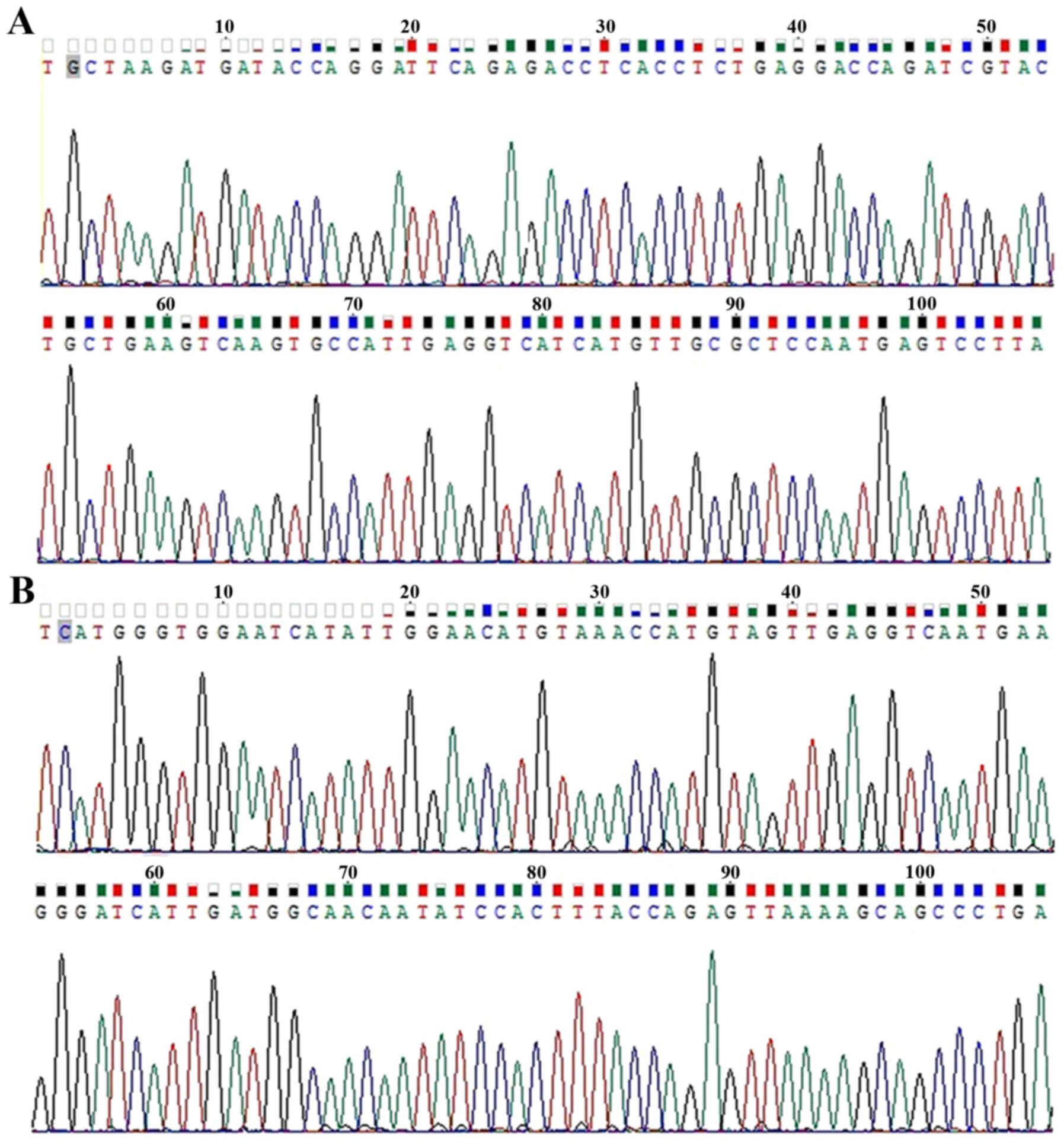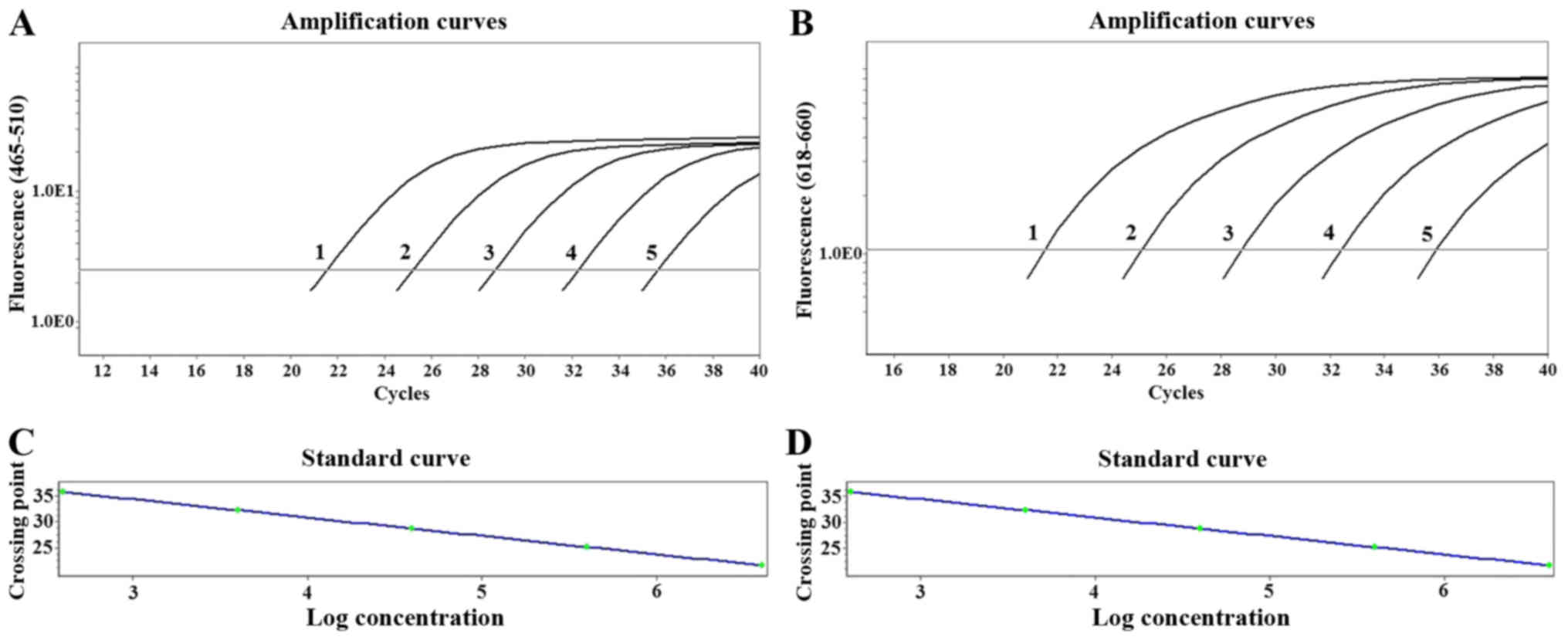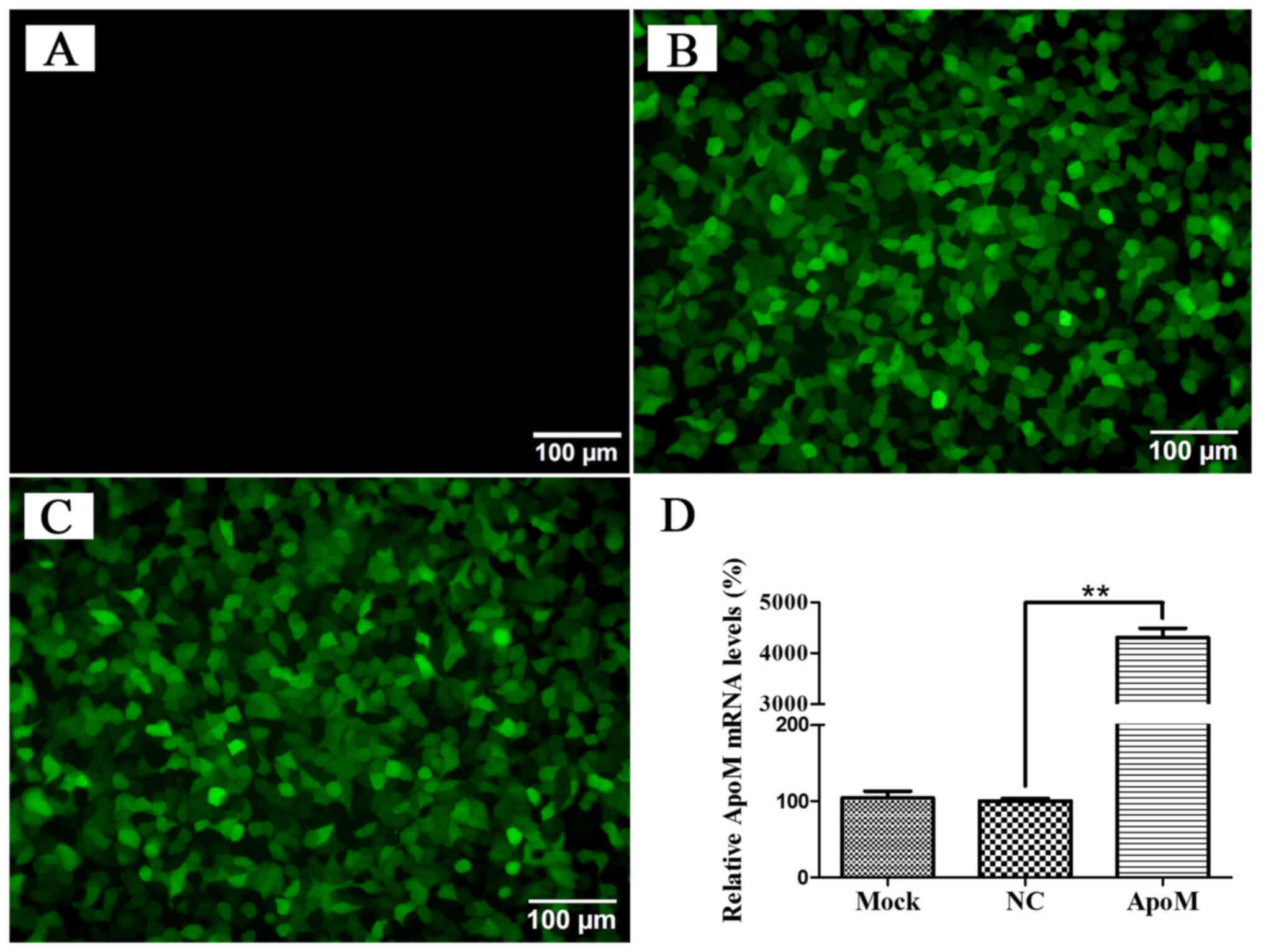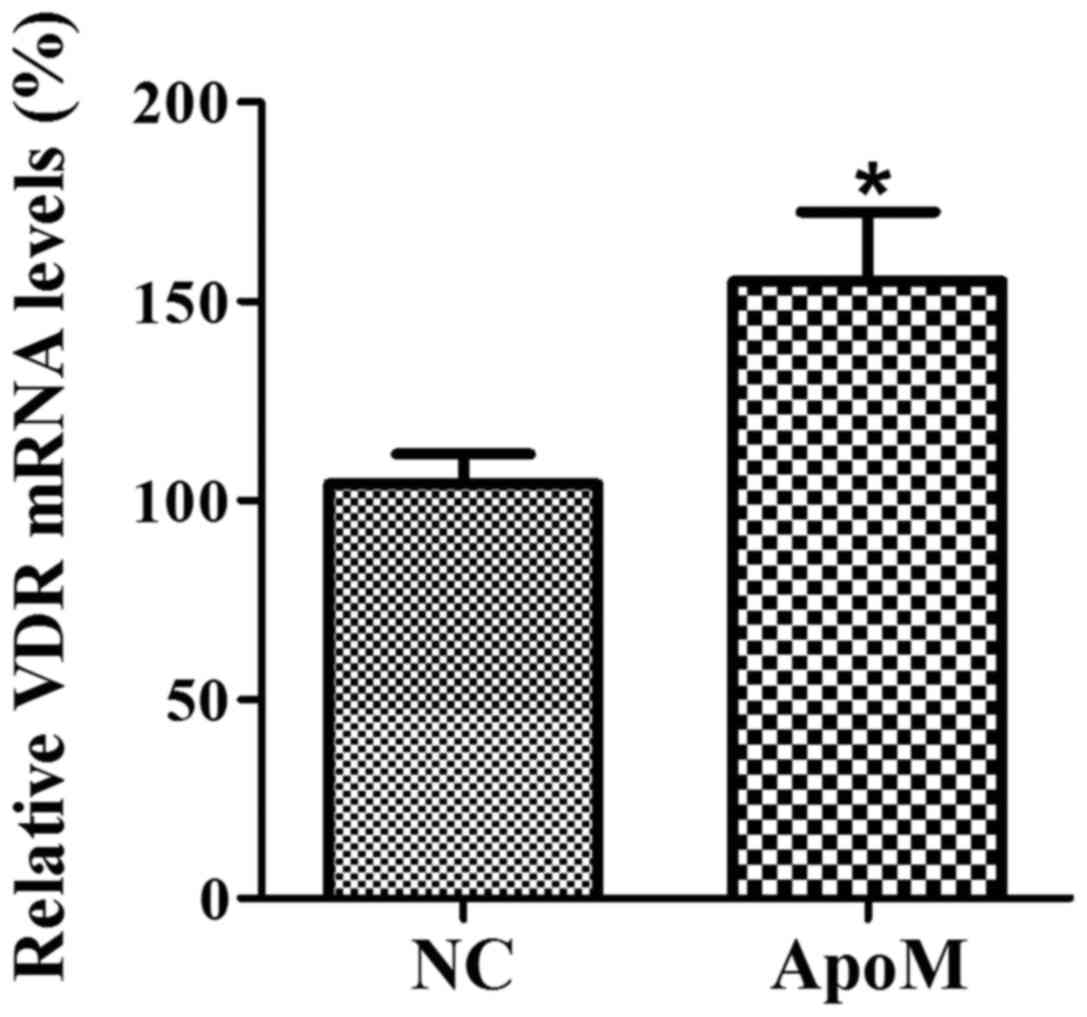Apolipoprotein M increases the expression of vitamin D receptor mRNA in colorectal cancer cells detected with duplex fluorescence reverse transcription-quantitative polymerase chain reaction
- Authors:
- Published online on: June 7, 2017 https://doi.org/10.3892/mmr.2017.6716
- Pages: 1167-1172
-
Copyright: © Yu et al. This is an open access article distributed under the terms of Creative Commons Attribution License.
Abstract
Introduction
Apolipoprotein M (ApoM), which was first discovered and isolated by Xu and Dahlbäck (1) in 1999, belongs to the lipocalin superfamily. ApoM is predominantly associated with high-density lipoprotein (HDL) particles in plasma, accounts for ~5% of HDL and an even smaller proportion (0.2~1%) of low-density lipoprotein (LDL) particles. ApoM is exclusively expressed in the liver and kidney and serves various functions. Wolfrum et al (2) demonstrated that ApoM enables pre-β-HDL to be transformed into mature HDL particles, which are involved in cholesterol efflux and may form the basis of the antiatherogenic effect. The anti-inflammatory effects of ApoM may also be associated with its anti-atherosclerotic effects (3). Arkensteijn et al (4) reported that S1P-ApoM can activate the S1P-1 receptor and affect the functions of endothelial cells. A previous study demonstrated that ApoM was expressed in human intestinal tissues and may be associated with lymph node metastasis of colorectal cancer (5). Thus, ApoM functions in the cellular cholesterol efflux capacity, anti-inflammatory activity, protection of the endothelium and tumorigenesis.
The vitamin D receptor (VDR) is a karyophilic protein that belongs to the steroid-thyroid receptor superfamily. The bioactive, hormonal ligand for VDR is 1,25-dihydroxyvitamin D3 [1,25-(OH)2D3] (6). VDR is widely distributed in various tissues and organs, and is highly expressed in the colon, kidney, skeleton and lymphocytes. VDR functions as a ligand-induced nuclear transcription factor to regulate various biological processes (7). Li et al (8) reported that increases of circulating cholesterol in vitamin D deficiency is associated with the reduction of transcriptional activity of VDR. Preclinical studies have established that VDR additionally has multifarious antitumor effects (particularly against colorectal cancer), including anti-proliferation, pro-differentiation, pro-apoptosis, anti-angiogenesis and anti-inflammatory effects (9,10). These results suggest that ApoM and VDR may have similar functions in cholesterol metabolism, immune and tumor regulation.
In the present study, whether ApoM affected the expression of VDR in colorectal cancer cells was investigated. A standardized method for determining ApoM and VDR mRNA levels is required. In the present study, a single-tube duplex RT-qPCR system was used to simultaneously detect VDR and GAPDH expression, which could efficiently shorten time and reduce errors, and provide a powerful tool in studying the functions and mechanisms of target genes.
Materials and methods
Cell line and cell culture
Human colorectal cancer cell line HT-29 was purchased from the Type Culture Collection of the Chinese Academy of Sciences (Shanghai, China). HT-29 cells were cultured in McCoy's 5A (modified) medium containing 10% fetal bovine serum (FBS; Gibco; Thermo Fisher Scientific, Inc., Waltham, MA, USA), Penicillin-Streptomycin (100 U/ml penicillin and 100 µg/ml streptomycin; Gibco; Thermo Fisher Scientific, Inc.), and were incubated at 37°C with 5% CO2.
Lentiviral infection and efficiency detection
Lentiviral particles containing the GV365 expression vector encoding ApoM and scrambled sequence (as a negative control) were synthesized by GeneChem Co., Ltd. (Shanghai, China) and were transduced into HT-29 cells following the manufacturer's instructions. Cells infected with lentiviral vector were seeded at a density of 1×105 cells/well in 6-well plates. The successfully virus-infected cells, being green fluorescent protein (GFP)-positive, were observed with fluorescence microscopy after 72 h, and the infection efficiency was detected by RT-qPCR.
Primers and probes design
The base sequences of ApoM (NM_019101, NM_001256169 and NR_045828), VDR (NM_000376, NM_001017535 and NM_001017536) and GAPDH (NM_002046, NM_001256799, NM_001289745 and NM_001289746) were obtained from GenBank (https://www.ncbi.nlm.nih.gov/genbank/). Primers and TaqMan probes were designed by Primer Premier 5.0 and synthesized by Sangon Biotech Co., Ltd. (Shanghai, China). The TaqMan probe of VDR was labeled with a BHQ1 quencher dye at 3′-end, and with FAM reporter dye at 5′-end. The TaqMan probe of GAPDH was labeled with a BHQ2 quencher dye at 3′-end, and with CY5 reporter dye at 5′-end. Sequence data are presented in Table I.
RNA extraction and reverse transcription
Total RNA was extracted using the Total RNA Purification kit (Shenergy Biocolor Bioscience and Technology, Shanghai, China) according to the manufacturer's instructions. The concentration and purity of total RNA were spectrophotometrically assessed, measuring absorbance at 260/280 nm by BioPhotometer (Eppendorf, Hamburg, Germany). RNA samples with a 260/280 nm ratio in the range 1.8~2.0 were considered as high quality and selected for further analysis. A total of 2 µl cDNA synthesized by the RevertAid First Strand cDNA Synthesis kit (Thermo Fisher Scientific, Inc.) was used for PCR.
Duplex fluorescence RT-qPCR
RT-qPCR was performed using Immolase™ DNA Polymerase (Bioline USA, Taunton, MA, USA) and analyzed by LightCycler 480 II PCR system (Roche Diagnostics GmbH, Mannheim, Germany). Amplification reactions contained 2.5 µl 10X ImmoBuffer, 1 µl 10 mM dNTPs, 2 µl 50 mM MgCl2, 0.04 µl of each 100 µM primer and probe (Table I, synthesized by Sangon Biotech Co., Ltd.), 0.5 µl DNA polymerase, 2 µl template (replaced by water in no template controls) and nuclease-free water in a final volume of 25 µl. The optimum conditions for PCR were as follows: 95°C denaturation for 10 min, and 40 cycles of amplification for 5 sec at 95°C and 15 sec at 60°C. PCR products were cloned and sequenced by Sangon Biotech Co., Ltd., and the gained recombinant plasmids were used as the standards for absolute quantitation of DNA copy number (11).
Preparation of VDR/GAPDH plasmid standard mixture
The concentrations of recombinant plasmids were determined using a spectrophotometer. VDR and GAPDH plasmid were mixed with equal volumes and copies (4×106 copies/µl) and used as the templates for PCR amplification. Subsequently, 10-fold serial dilutions (from 4×105~4×101 copies/µl) of extracted plasmid DNA were used to generate a standard curve by plotting the cycle threshold vs. the log initial copy number of input plasmid DNA.
Sensitivity and repeatability of duplex RT-qPCR method
The sensitivity of our assay was assessed using a 10-fold dilution series (from 4×105-4×101 copies/µl) of VDR/GAPDH plasmid standard mixture. The limit of detection was based on the final dilution at which the signal of the TaqMan probes was exponentially amplified. Each sample was amplified five times in five parallel reactions to detect the intra- and inter-repeatability of the assay.
Statistical analysis
Statistical testing was conducted with the assistance of GraphPad Prism software, version 5.0 (GraphPad Software, Inc., La Jolla, CA, USA). All data are presented as the mean ± standard error or the mean ± standard deviation. Student's t-test (two-tailed) was used to compare two groups. One-way analysis of variance was used to analyze multiple groups. P<0.05 was considered to indicate a statistically significant difference.
Results
Sequence analysis of recombinant plasmid
The sequence alignment indicated that the sequence of VDR (Fig. 1A) and GAPDH (Fig. 1B) recombinant plasmids completely matched with their respective gene sequences, which confirmed that the amplification products were the specific fragments of VDR and GAPDH, respectively.
Amplification curve of VDR/GAPDH and sensitivity analysis
The results indicated that a typical amplification curve of VDR gene was present in the FAM (465–510 nm) channels (Fig. 2A), and that of GAPDH gene was produced in the CY5 (618–660 nm) channels (Fig. 2B). Amplification of 10-fold serially diluted VDR/GAPDH plasmid mixture indicated that the sensitivity of this method was 4×101 copies/µl.
Establishment of standard curve and linearity range
Standard curves were generated from serial dilutions of plasmid cDNA standards for VDR and GAPDH. The standard curve equation of VDR and GAPDH amplification were Y=−3.518X+41.18 (Fig. 2C), and Y=−3.369X+41.50 (Fig. 2D), respectively, where Y represented Cq and X stood for the logarithm of initial copy number. The linearity range of the standard curve was between 4×101 and 4×105 copies/µl. Standard curves for each plasmid cDNA standard demonstrated linearity over the complete range of dilution series with correlation coefficients of 0.999. The amplification efficiency of VDR and GAPDH were 92.42% and 98.07%, respectively.
Repeatability of duplex RT-qPCR
The amplification of VDR and GAPDH had a precise intra- and inter-assay repeatability. The intra-assay coefficient of variation (CV) [intra-assay CV] respectively were 0.09–0.34% and 0.19–0.43% (Table II). Inter-assay CV respectively were 0.32–0.65% and 0.40–0.75% (Table III). Data are presented as the mean ± standard error.
ApoM overexpression in HT-29 cells
To further study the biological role of ApoM in colorectal cancer progression, HT-29 cells were transfected with the GFP-labeled lentiviral vector carrying ApoM. As shown in Fig. 3A-C, transfection efficiency was >90% based on the percentages of GFP-positive cells after transfection with a GFP expression vector. RT-qPCR was conducted in order to detect the expression levels of ApoM in HT-29 cells of each group. The PCR results indicated that the levels of ApoM mRNA in the experimental group were significantly higher (~40 fold) than that of the negative control group (Fig. 3D).
ApoM increases the expression of VDR mRNA in HT-29 cells
In order to evaluate whether overexpression of ApoM can affect the expression of VDR in HT-29 cells, the VDR mRNA levels were detected by duplex RT-PCR. The results indicated that ApoM can significantly increase the expression of VDR in HT-29 cells, compared with the negative control group (Fig. 4).
Discussion
RT-qPCR is known as the gold standard for accurate, sensitive and fast quantification of nucleic acid sequences. It is commonly used to analyze alterations of gene expression levels in tumors, microbes and other disease states. However, data normalization is a crucial step in gene quantification analysis. Usually, the expression level of the target genes are normalized using internal control genes known as reference genes, including GAPDH, β-actin, 18S ribosomal RNA and β-2 microglobulin to derive changes in gene expression levels (12). Traditionally, target and reference genes are detected in two divided tubes, which is wasteful, time consuming and may lead to experimental errors in the cDNA addition step (13,14). In the developed duplex qPCR used in the present study, the two gene expression levels could be determined simultaneously in a single tube, which effectively improved the efficiency of amplification and eliminated errors in sample addition steps. The methodology used produced high sensitivity, repeatability and amplification efficiency intra- and inter-assay. The linearity range of the standard curve was between 4×101 and 4×105 copies/µl.
In the methods used in the current study, the design and selection of primers were crucial to obtain the desired results of PCR. The ideal qPCR primers and probes design should consider the following points: i) All annotated splice variants of each gene should be taken into account when the biological function of individual gene splice variants remain to be understood (15). For example, VDR has three splice variants while GAPDH has four. The primers and probes of VDR and GAPDH were all designed in the common sequence of all splice variants; ii) primers are required to span exons to avoid amplification of contaminating genomic DNA; iii) a similarity search was used to ensure the specificity of each primer (16). All the above points are important for the method to obtain accurate and optimal results.
ApoM is a lipoprotein-associated plasma protein of the apolipoprotein family. ApoM protects against atherosclerosis primarily via partaking in pre-β-HDL formation and promoting cholesterol efflux to HDL (17,18). The process of atherosclerosis is always accompanied by an inflammatory reaction (3). As the human ApoM gene is located in the major histocompatibility complex class III region on chromosome 6, with multiple immune and inflammatory response-associated genes, it is suggested be involved in immune response (19). The anti-inflammatory effect of ApoM is regarded as one pathway of its atheroprotective. Additionally, it has been previously reported that ApoM is abnormally expressed in hepatocellular carcinoma and the colorectal cancer tissues (5), which indicates that ApoM may participate in tumor regulation. However, the role and regulatory mechanism for ApoM in tumor progression remains to be further elucidated.
VDR functions as a transcription factor that regulates various biological processes including the regulation of proliferation, differentiation, apoptosis, angiogenesis, immunity and miRNAs (9). Studies have reported an antineoplastic effect of VDR, particularly in colorectal cancer; VDR expression is increased in well-differentiated or moderately differentiated colorectal cancer tissues, however is decreased in poorly differentiated tumors (20), and high VDR expression is correlated with an advantageous prognosis in colorectal patients (21). In addition, studies in different animal models and cell lines of colorectal cancer support the antineoplastic effect of VDR via various mechanisms (22–24).
A previous study indicated that mRNA and protein levels of ApoM are significantly reduced in the colorectal cancer tissues when compared with their matched adjacent normal tissues. From this result, it was hypothesized that ApoM may serve an anti-tumor role in colorectal cancer. In the present study, it was demonstrated that overexpression of ApoM could significantly increase the expression of VDR mRNA in HT-29 cells. In addition, associated studies have confirmed that VDR has antineoplastic effect (25–27). This may suggest that ApoM serves an antineoplastic role during the progress of the colorectal cancer by upregulating VDR expression. As chronic inflammation is regarded as a risk factor for the development of cancer, the suppression of inflammation by ApoM and VDR may contribute to their antineoplastic activity. It is suggested that the duplex RT-qPCR used in the present study could ensure objectivity and credibility.
In conclusion, a single-tube duplex RT-qPCR to simultaneously detect VDR and GAPDH expression in colorectal cancer cells was successfully developed. The methodology results demonstrated that the duplex RT-qPCR with high sensitivity and specificity could ensure the accuracy of detection. Subsequently, it was identified that ApoM significantly increased the expression of VDR in HT-29 cells. In addition, it was suggested that ApoM may be involved in antineoplastic activity via upregulation of VDR expression, which provided novel directions for the investigation of ApoM in cancer.
Acknowledgements
The present study was supported by the Changzhou High-Level Medical Talents Training Project (grant no. 2016ZCLJ002).
References
|
Xu N and Dahlbäck B: A novel human apolipoprotein (apoM). J Biol Chem. 274:31286–31290. 1999. View Article : Google Scholar : PubMed/NCBI | |
|
Wolfrum C, Poy MN and Stoffel M: Apolipoprotein M is required for prebeta-HDL formation and cholesterol efflux to HDL and protects against atherosclerosis. Nat Med. 11:418–422. 2005. View Article : Google Scholar : PubMed/NCBI | |
|
Huang XS, Zhao SP, Hu M and Luo YP: Apolipoprotein M likely extends its anti-atherogenesis via anti-inflammation. Med Hypotheses. 69:136–140. 2007. View Article : Google Scholar : PubMed/NCBI | |
|
Arkensteijn BW, Berbée JF, Rensen PC, Nielsen LB and Christoffersen C: The apolipoprotein m-sphingosine-1-phosphate axis: Biological relevance in lipoprotein metabolism, lipid disorders and atherosclerosis. Int J Mol Sci. 14:4419–4431. 2013. View Article : Google Scholar : PubMed/NCBI | |
|
Luo G, Zhang X, Mu Q, Chen L, Zheng L, Wei J, Berggren-Söderlund M, Nilsson-Ehle P and Xu N: Expression and localization of apolipoprotein M in human colorectal tissues. Lipids Health Dis. 9:1022010. View Article : Google Scholar : PubMed/NCBI | |
|
Gonzalez-Parra E, Rojas-Rivera J, Tuñón J, Praga M, Ortiz A and Egido J: Vitamin D receptor activation and cardiovascular disease. Nephrol Dial Transplant. 27 Suppl 4:iv17–21. 2012. View Article : Google Scholar : PubMed/NCBI | |
|
Christakos S, Dhawan P, Verstuyf A, Verlinden L and Carmeliet G: Vitamin D: Metabolism, molecular mechanism of action, and pleiotropic effects. Physiol Rev. 96:365–408. 2016. View Article : Google Scholar : PubMed/NCBI | |
|
Li S, He Y, Lin S, Hao L, Ye Y, Lv L, Sun Z, Fan H, Shi Z, Li J, et al: Increase of circulating cholesterol in vitamin D deficiency is linked to reduced vitamin D receptor activity via the Insig-2/SREBP-2 pathway. Mol Nutr Food Res. 60:798–809. 2016. View Article : Google Scholar : PubMed/NCBI | |
|
Dou R, Ng K, Giovannucci EL, Manson JE, Qian ZR and Ogino S: Vitamin D and colorectal cancer: Molecular, epidemiological and clinical evidence. Br J Nutr. 115:1643–1660. 2016. View Article : Google Scholar : PubMed/NCBI | |
|
Feldman D, Krishnan AV, Swami S, Giovannucci E and Feldman BJ: The role of vitamin D in reducing cancer risk and progression. Nat Rev Cancer. 14:342–357. 2014. View Article : Google Scholar : PubMed/NCBI | |
|
Nurmi J, Ylikoski A, Soukka T, Karp M and Lövgren T: A new label technology for the detection of specific polymerase chain reaction products in a closed tube. Nucleic Acids Res. 28:E282000. View Article : Google Scholar : PubMed/NCBI | |
|
Angelone-Alasaad S, Min A Molinar, Pasquetti M, Alagaili AN, D'Amelio S, Berrilli F, Obanda V, Gebely MA, Soriguer RC and Rossi L: Universal conventional and real-time PCR diagnosis tools for Sarcoptes scabiei. Parasit Vectors. 8:5872015. View Article : Google Scholar : PubMed/NCBI | |
|
Parker J, Fowler N, Walmsley ML, Schmidt T, Scharrer J, Kowaleski J, Grimes T, Hoyos S and Chen J: Analytical Sensitivity Comparison between Singleplex Real-Time PCR and a Multiplex PCR Platform for Detecting Respiratory Viruses. PLoS One. 10:e01431642015. View Article : Google Scholar : PubMed/NCBI | |
|
Shen Z: Effect of reaction tube on the accuracy of polymerase chain reaction. J Prac Medi Tech. 17:142–143. 2010. | |
|
Gubelmann C, Gattiker A, Massouras A, Hens K, David F, Decouttere F, Rougemont J and Deplancke B: GETPrime: A gene- or transcript-specific primer database for quantitative real-time PCR. Database (Oxford). 2011:bar0402011. View Article : Google Scholar : PubMed/NCBI | |
|
Wang X, Spandidos A, Wang H and Seed B: PrimerBank: A PCR primer database for quantitative gene expression analysis, 2012 update. Nucleic Acids Res. 40(Database issue): D1144–D1149. 2012. View Article : Google Scholar : PubMed/NCBI | |
|
Huang LZ, Gao JL, Pu C, Zhang PH, Wang LZ, Feng G and Zhang Y: Apolipoprotein M: Research progress, regulation and metabolic functions (Review). Mol Med Rep. 12:1617–1624. 2015.PubMed/NCBI | |
|
Elsøe S, Christoffersen C, Luchoomun J, Turner S and Nielsen LB: Apolipoprotein M promotes mobilization of cellular cholesterol in vivo. Biochim Biophys Acta. 1831:1287–1292. 2013. View Article : Google Scholar : PubMed/NCBI | |
|
Luo G, Zhang X, Nilsson-Ehle P and Xu N: Apolipoprotein M. Lipids Health Dis. 3:212004. View Article : Google Scholar : PubMed/NCBI | |
|
Matusiak D, Murillo G, Carroll RE, Mehta RG and Benya RV: Expression of vitamin D receptor and 25-hydroxyvitamin D3-1{alpha}-hydroxylase in normal and malignant human colon. Cancer Epidemiol Biomarkers Prev. 14:2370–2376. 2005. View Article : Google Scholar : PubMed/NCBI | |
|
Milczarek M, Filip-Psurska B, Swiętnicki W, Kutner A and Wietrzyk J: Vitamin D analogs combined with 5-fluorouracil in human HT-29 colon cancer treatment. Oncol Rep. 32:491–504. 2014.PubMed/NCBI | |
|
Elimrani I, Koenekoop J, Dionne S, Marcil V, Delvin E, Levy E and Seidman EG: Vitamin D Reduces Colitis- and Inflammation-Associated Colorectal Cancer in Mice Independent of NOD2. Nutr Cancer. 69:276–288. 2017. View Article : Google Scholar : PubMed/NCBI | |
|
Vidigal VM, Silva TD, de Oliveira J, Pimenta CAM, Felipe AV and Forones NM: Genetic polymorphisms of vitamin D receptor (VDR), CYP27B1 and CYP24A1 genes and the risk of colorectal cancer. Int J Biol Markers. 32:e224–e230. 2017. View Article : Google Scholar : PubMed/NCBI | |
|
Takada I and Makishima M: Control of inflammatory bowel disease and colorectal cancer by synthetic vitamin D receptor ligands. Curr Med Chem. Dec 2–2016.(Epub ahead of print). | |
|
Yazdani S, Poosti F, Toro L, Wedel J, Mencke R, Mirković K, de Borst MH, Alexander JS, Navis G, van Goor H, et al: Vitamin D inhibits lymphangiogenesis through VDR-dependent mechanisms. Sci Rep. 7:444032017. View Article : Google Scholar : PubMed/NCBI | |
|
Chiang KC, Yeh TS, Huang CC, Chang YC, Juang HH, Cheng CT, Pang JS, Hsu JT, Takano M, Chen TC, et al: MART-10 represses cholangiocarcinoma cell growth and high vitamin D receptor expression indicates better prognosis for cholangiocarcinoma. Sci Rep. 7:437732017. View Article : Google Scholar : PubMed/NCBI | |
|
Tavera-Mendoza LE, Westerling T, Libby E, Marusyk A, Cato L, Cassani R, Cameron LA, Ficarro SB, Marto JA, Klawitter J and Brown M: Vitamin D receptor regulates autophagy in the normal mammary gland and in luminal breast cancer cells. Proc Natl Acad Sci USA. 114:E2186–E2194. 2017. View Article : Google Scholar : PubMed/NCBI |













